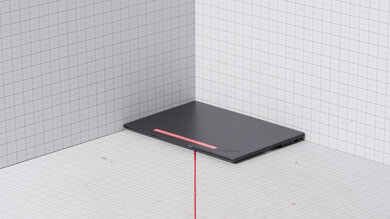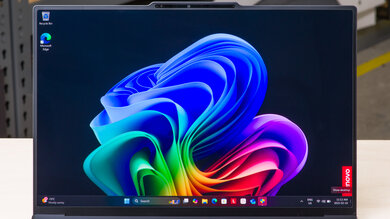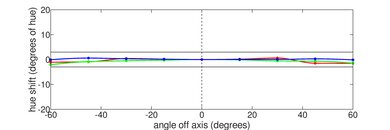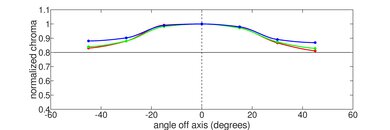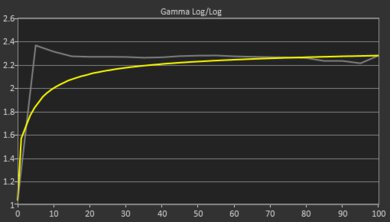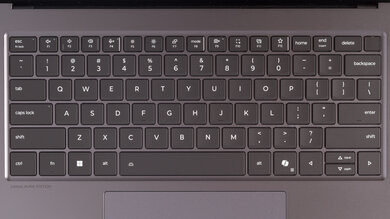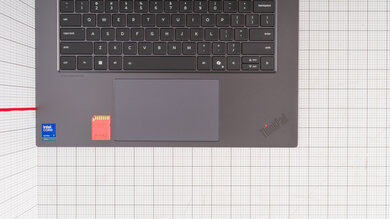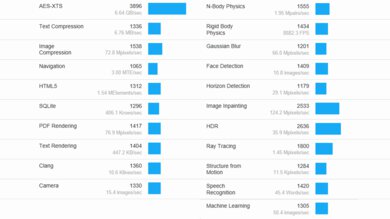The Lenovo IdeaPad Slim 3i 15 (2023) is a budget Windows laptop. It's available with various Intel 13th Gen CPUs, up to a Core i7-1355U. You can configure it with 8GB or 16GB of RAM and up to 1TB of storage. There are also multiple FHD (1920 x 1080) display options, including a TN panel and an IPS touchscreen display. Keyboard backlighting and the fingerprint sensor are optional features. Ports include two USB-As, one USB-C (no Thunderbolt support), an HDMI 1.4, an SD card reader, and a 3.5 mm headphone jack. Although our model has a 720p webcam, you can also get this laptop with a 1080p webcam.
See our unit's specifications and the available configuration options in the Differences Between Variants section below.
Our Verdict
The Lenovo IdeaPad 3i is decent for school use. It feels sturdily built, and it's easy to carry around, thanks to its compact design. It has a 1080p display that provides plenty of room for multitasking, a comfortable keyboard, and a small but responsive touchpad. Its Intel CPU can handle light productivity tasks but isn't ideal for demanding workloads. Also, it's only available with integrated graphics, so it isn't suitable for students in technical fields like 3D design. Unfortunately, the battery lasts only six to seven hours of light use.
-
Easy to carry around.
-
Sturdy build.
-
Screen provides enough room for multitasking.
-
Comfortable keyboard.
-
Battery lasts only six to seven hours of light use.
-
CPU and GPU can't handle demanding tasks.
-
Small touchpad.
The Lenovo IdeaPad 3i is mediocre for gaming. It's only available with low-power CPUs and integrated graphics, which aren't powerful enough to handle graphically intensive games. It also has a slow 60Hz display with no VRR support to reduce screen tearing. You can play some lighter, casual games on the Core i5 and i7 models, but you'll have to play with low settings to get playable frame rates. It has a fast SSD, though, and it doesn't get hot or loud under load.
-
Fast SSD.
-
Doesn't get hot or loud under load.
-
CPU and GPU can't handle demanding tasks.
-
60Hz display with slow response time.
-
No VRR to reduce screen tearing.
The Lenovo IdeaPad 3i is okay for media consumption. It's a very portable laptop, and its battery lasts around six hours of video playback, giving you enough time to get through a couple of full-length movies. Its 1080p display looks decently sharp, but it produces washed-out colors due to its narrow color gamut, and its low contrast ratio makes blacks look gray in dim settings. Unfortunately, while the speakers get very loud, they sound tinny and unnatural, with no bass.
-
Easy to carry around.
-
Battery lasts around six hours of video playback.
-
Speakers get very loud.
-
Display looks washed out.
-
Blacks look gray in dim settings.
-
Speakers sound tinny and unnatural, with no bass at all.
The Lenovo IdeaPad 3i is decent for use as a workstation. Its Intel CPU and integrated graphics can only handle light productivity tasks, not demanding workloads like video editing or 3D graphics. You also can't do any color-critical work because the available displays have a narrow color gamut. It has a good port selection, but its USB-C lacks Thunderbolt 4 support. On the upside, it has a comfortable keyboard and doesn't get hot or loud under load.
-
Fast SSD.
-
Doesn't get hot or loud under load.
-
Good port selection.
-
CPU and GPU can't handle demanding tasks.
-
No Thunderbolt 4 support.
-
Display isn't suitable for color-critical work.
The Lenovo IdeaPad 3i is good for business use. It has a sturdy build, and its thin and light design makes it easy to carry around. The display provides plenty of room for multitasking, the keyboard feels comfortable to type on, and while the touchpad is small, it tracks all movements and gestures well. Its Intel CPU can easily handle productivity tasks like text processing, spreadsheets, video playback, and presentations. The battery lasts only around six to seven hours of light use, though, so you'll have to bring the charger with you.
-
Easy to carry around.
-
Sturdy build.
-
Screen provides enough room for multitasking.
-
Comfortable keyboard.
-
Battery lasts only six to seven hours of light use.
-
CPU and GPU can't handle demanding tasks.
-
Small touchpad.
- School
- Gaming
- Multimedia
- Workstation
- Business
- Updated Jul 25, 2024: Added mention of the HP Pavilion Aero 13 (2024) as a more compact alternative in the Portability section.
- Updated Apr 30, 2024: We've updated the review for clarity.
- Updated Dec 07, 2023: Converted to Test Bench 0.8.2.
- Updated Nov 03, 2023: Converted to Test Bench 0.8.1.
- Updated May 05, 2023: Review published.
- Updated May 04, 2023: Early access published.
- Updated Apr 24, 2023: Our testers have started testing this product.
- Updated Apr 21, 2023: The product has arrived in our lab, and our testers will start evaluating it soon.
- Updated Apr 12, 2023: We've purchased the product and are waiting for it to arrive in our lab.
Differences Between Sizes And Variants
We tested the Lenovo IdeaPad Slim 3i 15IRU8 (model 82X7000CUS) with an FHD (1920 x 1080) IPS touchscreen display, an Intel Core i3-1315U CPU, 8GB of memory, and 512GB of storage. The screen, CPU, memory, and storage are configurable; you can see the available options in the table below. Our review only applies to variants with a model number starting with '82X7.'
| Screen |
|
|---|---|
| CPU |
|
| GPU |
|
| Memory |
|
| Storage |
|
| Color |
|
See our unit's label here.
Compared To Other Laptops
The Lenovo IdeaPad 3i is a decent budget laptop. Its build quality, keyboard, and performance are better than most laptops in its class; however, its battery life isn't as good.
For more options, check out our recommendations for the best laptops, the best laptops for college, and the best budget and cheap laptops.
The Lenovo IdeaPad Slim 3i 15 (2023) is better than the Acer Aspire 3 15 (2023) for most uses. The IdeaPad Slim 3i has a sturdier build, a brighter display, a more comfortable keyboard, and a more responsive touchpad. It also has a fingerprint sensor and is available with faster CPUs.
The Lenovo IdeaPad Slim 3i 15 (2023) and the Lenovo IdeaPad 3 15 (2021) are very similar overall. The Slim 3i has a better keyboard and a more responsive touchpad, and its USB-C supports video output and charging. Also, the IdeaPad Slim 3i is available with newer and faster Intel 13th Gen. CPUs. However, the IdeaPad 3 15's screen gets slightly brighter to combat glare, and its battery lasts longer.
The Lenovo IdeaPad Slim 3i 15 (2023) and the ASUS Vivobook 16 M1605 (2023) are both budget Windows ultraportables that offer a similar user experience. The ASUS comes out slightly ahead, as its keyboard feels more comfortable to type on, and its touchpad is larger and more responsive. However, the Lenovo has a wider port selection that includes a full-size SD card reader and support for video output via USB-C. Performance-wise, you can get more performance out of the Lenovo if you get a higher-end configuration with a Core i5 or i7. However, you likely won't notice much difference between these two laptops if you only perform light, general productivity tasks like web browsing and text processing.
The Lenovo IdeaPad Slim 3i 15 (2023) is better than the MSI Modern 14 (2023) for most uses. The Lenovo has a sturdier build, a better keyboard and webcam, a longer battery life, and a fingerprint sensor. However, the Lenovo is more portable since it's a smaller device.
The Lenovo IdeaPad Slim 3i (2023) is better than the Dell Inspiron 15 3000 (2020) for most uses. The IdeaPad Slim 3i has a brighter display, a more comfortable keyboard, and a better webcam. Additionally, it's available with faster CPUs and doesn't get as hot or loud under load.
The Lenovo IdeaPad Slim 3i 15 (2023) and the Acer Swift 3 14 (2020) are both budget ultraportable laptops. The Swift 3 is more portable since it's a smaller device, and its battery lasts much longer. It doesn't have as many ports as the IdeaPad Slim 3i, as it lacks an SD card reader, but its USB-C supports Thunderbolt 4, whereas the IdeaPad Slim 3i doesn't. On the other hand, the IdeaPad Slim 3i has a better keyboard, touchpad, and webcam, and it's available with newer and faster Intel 13th Gen. CPUs.
The Lenovo IdeaPad Slim 3i 15 (2023) is much better than the Acer Aspire 3 Spin 14 (2023) for most uses. The IdeaPad has a better keyboard, touchpad, and webcam. Additionally, it's available with faster CPUs and more RAM, so it can handle more demanding workloads with fewer slowdowns. However, the IdeaPad is only a clamshell model, while the Aspire is a 2-in-1 convertible, meaning you can use it as a tablet. The Aspire's battery lasts longer, though neither laptop can last through a typical eight-hour workday.
The HP Pavilion Aero 13 (2024) is a much better laptop overall than the Lenovo IdeaPad Slim 3i 15 (2023). The HP has better performance, longer battery life, and a more portable form factor. This makes it ideal for people who need a device for general productivity tasks on the go. However, the 13-inch screen may be too restrictive for some people, particularly if you need to multitask or have multiple documents open simultaneously. In this case, the Lenovo is a fine alternative.
The Acer Aspire 5 15 (2023) and the Lenovo IdeaPad Slim 3i 15 (2023) are both 15-inch budget laptops. The Lenovo provides a better user experience, sporting a more tactile keyboard, a more responsive touchpad, and a better webcam. However, you can get more performance out of the Acer because it's available with faster H-series CPUs. The Acer also has better battery life, lasting almost two hours longer than the Lenovo.
Test Results
The Lenovo IdeaPad 3i's design is simple and doesn't stand out in any way. It has a plastic chassis, relatively thin bezels around the display, a full-size keyboard with a numpad on the right, and ports on both sides. The speaker grills are at the top of the keyboard deck, and the air vents are on the bottom. This laptop is available in three colors: Abyss Blue, Artic Gray, and Frost Blue; however, availability varies depending on the region.
The Lenovo IdeaPad 3i's build quality is good. It's entirely plastic but feels sturdy; it just doesn't feel as premium as higher-end devices. There's some flex in the display and keyboard deck, but almost none on the lid when the laptop is closed. The finish doesn't pick up fingerprints or scratch easily, and the feet feel solid and stick firmly to the bottom.
The hinge is okay. It doesn't feel particularly smooth but is very stable, so there's almost no screen wobble when typing. Unfortunately, you can't open the laptop with one hand because the base of the laptop is too light and lifts with the lid.
Consider the HP Pavilion Aero 13 (2024) if you want a more compact mid-range option.
The Lenovo IdeaPad 3i's serviceability is decent. Accessing the internals is straightforward; you only need to remove 10 Philips screws and undo the clips holding the bottom panel. Unfortunately, the memory isn't user-replaceable, and there's only one storage drive slot.
You can see the maintenance manual here.
- Lenovo IdeaPad Slim 3i laptop
- 65W power adapter and cord
- Documentation
The Lenovo IdeaPad 3i is available with the following displays:
- 15.6" TN 1920 x 1080 60Hz
- 15.6" IPS 1920 x 1080 60Hz
- 15.6" IPS 1920 x 1080 60Hz Touchscreen
A 1080p resolution looks decently sharp on a 15.6-inch screen. 16:9 is a standard aspect ratio that's well suited for media consumption since most videos are in the same format; however, a 16:10 or 3:2 aspect ratio would have been better for productivity, as the increased vertical space lets you see more text when reading a document or website, so you don't have to scroll as much. For the best viewing experience, it's best to get a model with an IPS panel because TN panels have worse viewing angles and color reproduction.
All available displays have a 60Hz refresh rate, which is typical for productivity laptops. The IPS (touchscreen) panel has a slow response time, causing noticeable ghosting, so it isn't ideal for viewing fast-moving content or gaming. The non-touch IPS and TN panels will perform similarly.
The contrast ratio is decent for an IPS panel but is still relatively low compared to other display technologies like VA and OLED. This contrast level makes blacks look gray in dim settings. The non-touch IPS panel will perform similarly, as it has the same advertised contrast; however, the TN panel will likely be worse, with an advertised contrast of 600:1.
The touchscreen IPS display gets reasonably bright. It's enough for use in most indoor settings but not outdoors in broad daylight. It gets very dim at the lowest brightness setting, which is great for dark room viewing as it causes less eye strain. The non-touch IPS panel will perform similarly. The TN panel is slightly dimmer, with an advertised brightness of 250 cd/m².
The reflection handling is excellent. The matte coating does a great job of diffusing and reducing the intensity of bright reflections. You can still see reflections when viewing light-color content with the screen at full brightness, but they aren't distracting.
The TN panel's uniformity will likely be much worse due to the TN panel's narrow viewing angles.

The horizontal viewing angle is okay. The image gets dimmer and more washed out fairly quickly when moving to the side, so you have to be close or directly in front of the screen to get the best accuracy. The TN panel will have a significantly worse viewing angle.

The vertical viewing angle is okay. Like the horizontal viewing angle, the image dims and washes out when viewing from above or below. You need to look at the screen almost straight on to get an accurate image, which can be hard in places where you don't have much space to tilt the screen, like on a bus or airplane. The TN panel's viewing angle will be worse as TN panels typically suffer from chroma inversion.
The Lenovo IdeaPad 3i's display accuracy is decent out of the box. The white balance is outstanding, but most colors are inaccurate due to the display's narrow color gamut. The color temperature is a tad cooler than the standard 6500K target, giving the image a slight, almost imperceptible, blueish tint. The gamma follows the sRGB curve reasonably well, although dark scenes look too dark, and bright scenes look too bright.
The display's color gamut is bad. It doesn't even have full coverage of the commonly used sRGB color space, making most content look washed out. Its Adobe RGB and DCI P3 coverage is also bad, so it isn't suitable for color-critical work like photo and video editing. The other displays perform similarly.
The Lenovo IdeaPad 3i has a good keyboard. The layout feels fairly spacious and is easy to get used to. The plastic used for the keycaps feels alright; it isn't particularly premium or cheap. As for the overall typing experience, the keyboard feels good to type on and doesn't cause fatigue over time. The keys have a lot of travel and don't require much force to actuate; however, they aren't the most stable keys, and the tactile feedback is just okay. Typing noise is relatively low and isn't bothersome in quiet settings. There's one backlight brightness level, so you can only turn it on or off. Backlighting is optional, so it's best to check the specifications if you need it.
The touchpad is decent. It tracks movements and gestures well; it's just small, making actions like dragging and dropping over a long distance more challenging. The surface feels smooth, allowing the fingers to glide easily, and there's no problem with palm rejection. Unfortunately, you can only click in the lower half of the touchpad, and the buttons feel a tad mushy.
The speakers are sub-par. Although they get very loud with minimal dynamic compression at max volume, they sound tinny, unnatural, and slightly sibilant. Also, they have no bass whatsoever.

The webcam is good. There's a fair amount of detail in the image, and the colors look natural; however, the exposure is slightly too high, and some smaller details look blurry due to noise. Voices sound loud and clear over the microphone with almost no background noise. Some models have a 1080p webcam, so it's best to check the specifications if you care about this. Keep in mind that a higher resolution doesn't always mean better image quality, as image processing tends to be more important when it comes to webcams.
The Lenovo IdeaPad 3i has a good port selection. Both USB-A ports support USB 3.2 Gen. 1 data transfer speed (up to 5Gbps). The USB-C also supports USB 3.2 Gen. 1 data transfer speed, DisplayPort 1.2 (video output up to 4k at 60Hz), and Power Delivery 3.0. The latter allows for fast charging of the laptop and other PD-compatible mobile devices connected to the port.
The Lenovo IdeaPad 3i's wireless adapter is a Realtek RTL8852BE.
The Lenovo IdeaPad 3i is available with the following CPUs:
- Intel Processor U300 (5 cores (1P + 4E)/6 threads, up to 4.4GHz, 8MB cache)
- Intel Core i3-1305U (5 cores (1P + 4E)/6 threads, up to 4.5Ghz, 10MB cache)
- Intel Core i3-1315U (6 cores (2P + 4E)/8 threads, up to 4.5GHz, 10MB cache)
- Intel Core i5-1335U (10 cores (2P + 8E)/12 threads, up to 4.6GHz, 12MB cache)
- Intel Core i7-1355U (10 cores (2P + 8E)/12 threads, up to 5.0GHz, 12MB cache)
All available CPUs are designed for general productivity tasks like web browsing, text processing, spreadsheets, and video playback. They all have a hybrid design with a mix of performance and efficiency cores. The Intel Processor U300 and Core i3-1305U have one performance core and four efficiency cores. The Core i3-1315U, i5-1335U, and i7-1355U have two performance cores, but the number of efficiency cores varies, from four on the Core i3 to eight on the Core i5 and i7. As usual, a higher core count and faster clock speeds will result in a smoother desktop experience with less slowdown when multitasking. The Core i5 and i7 can handle more demanding applications; however, if you're using your laptop for heavy workloads like 3D graphics or video editing, you're better off getting a laptop with an H-series processor, as those CPUs have more performance cores and run at a higher wattage.
The Lenovo IdeaPad 3i is only available with integrated graphics. The Processor U300 and Core i3s use Intel UHD Graphics (48 and 64 execution units, respectively), while the Core i5 and i7 use Intel Iris Xe (80 and 96 execution units, respectively). There's a performance difference between the various GPUs, but ultimately, they're all designed for light productivity tasks, not demanding workloads like video editing or 3D graphics. The Core i5 and i7's Intel Iris Xe can handle some lighter or older games, although you'll have to play with low graphical settings to get playable frame rates.
You can configure this laptop with 8GB or 16GB of RAM. The memory is soldered onto the motherboard and isn't user-replaceable, so get the best configuration for your needs upfront.
You can configure this laptop with 256GB, 512GB, or 1TB of storage. The SSD is user-replaceable; the slot supports an M.2 2242 PCIe Gen. 4 x4 NVMe SSD.
The Lenovo IdeaPad 3i has an overall good score in the Geekbench 5 benchmarks. These scores indicate that the Core i3-1315U can easily handle light productivity tasks but will struggle in extremely demanding multi-threaded workloads. The Core i5-1335U and i7-1355U are faster because they have more cores. That said, If you need to run intensive, heavily multi-threaded applications, it's best to get a laptop with an H-series processor. As for the GPU's performance, the Intel CPU's integrated graphics perform poorly and aren't suitable for heavy computing tasks.
The overall score in Cinebench R23 is excellent. However, if you're a professional with strict deadlines, you can get far better performance on a mobile workstation or gaming laptop with an H-series CPU. Upgrading to the Core i5 or i7 on this laptop will also give you better performance, but it won't be as good as an H-series processor.
The Lenovo IdeaPad 3i's performance in Blender is sub-par. The Core i3-1315U takes a long time to render the simple bmw27 scene. The Core i5 and i7 will perform significantly better, but it's still better to get a laptop with a dedicated GPU if you need to render images professionally. Even an entry-level GPU, like an NVIDIA GeForce GTX 1650, can render images much faster than almost any CPU.
The Lenovo IdeaPad 3i performs poorly in the Basemark GPU benchmark. The Intel U300 and Core i3s' UHD graphics can only handle simple card and puzzle games. The Core i5 and i7's Intel Iris Xe GPU isn't bad for integrated graphics; however, it's starting to show its age and isn't fast enough to provide smooth gameplay in graphically intensive titles. You can play some older or extremely well-optimized titles at 1080p, but you'll have to play at a lower resolution or with low graphical settings to get playable frame rates.
Borderlands 3 isn't playable on the Lenovo IdeaPad 3i laptop. The average frame rate is too low, even with low graphical settings, and the game sometimes freezes completely. Also, the game can only run on DirectX 11 because it keeps crashing on DirectX 12. The Core i5 and i7's Iris Xe will perform better, but not enough to make it playable. You can expect the same performance in other similarly demanding titles.
Civilization VI runs poorly at 1080p with high settings because the average frame rate is too low, even for a strategy game. However, it runs much more smoothly if you lower some graphical settings. The Core i5 and i7's Iris Xe graphics will provide smoother gameplay and faster turn times.
CS:GO runs poorly at 1080p. Although the average frame rate is over 60 fps with low graphical settings, the game stutters a lot due to frame drops. The Core i5 and i7 will push slightly more frames per second, but the game will still stutter.
Shadow of the Tomb Raider isn't playable at 1080p. The game is too choppy and sometimes freezes completely, even with low graphical settings. The integrated GPU simply can't handle this and other similarly demanding games. The Core i5 and i7 will perform better, but not enough to make the game playable.
The Lenovo IdeaPad 3i has good thermal and noise handling. The keyboard is only mildly warm when idle, and the fan is completely silent. Under load, the keyboard gets hotter but is by no means uncomfortable. Likewise, the fan is audible at full speed but isn't annoying or distracting.
The Lenovo IdeaPad 3i has many pre-installed applications, including:
- Dolby Access: Adds Dolby Atmos support and lets you tweak the speakers or headphones settings. Includes a seven-day trial; additional one-time purchase required for use after the trial period.
- Lenovo Hotkeys: Lets you create keyboard macros.
- Lenovo Smart Appearance: Improves your appearance on video calls.
- Lenovo Vantage: Checks for drivers and BIOS updates. It also lets you view the system's status and warranty information and access various settings, like power and audio profiles.
- Lenovo Voice: Text-to-speech application.
- Lenovo Welcome: Provides general information about the laptop for new users.
- McAfee LiveSafe: Antivirus and internet security software. Requires subscription.
- TikTok: Social media app.
You can get this laptop with Windows 11 Home pre-installed or without an operating system. Some models ship with Windows in S Mode, a stripped-down version of Windows designed for low-end hardware. It only lets you install apps from the Windows Store, which means you can't install apps like Google Chrome or Mozilla Firefox. You can switch out of S mode free of charge, but you can't go back to it once you've activated the full version of Windows.
The power button has an integrated fingerprint sensor. You can use it to log into Windows, authorize Windows Store purchases, and auto-fill saved passwords on supported websites. The fingerprint sensor is an optional feature, so it's best to check the specifications if this is a feature you care about.





